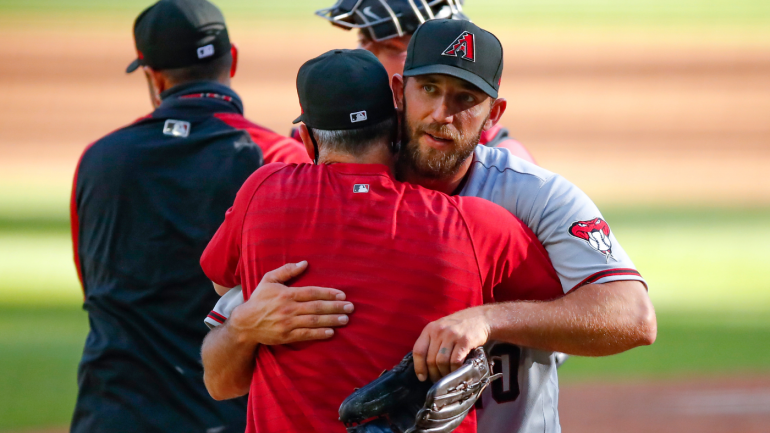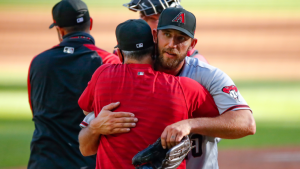
Written By: Nick Wilson

A flummoxed Freddy Freeman sat down on strikes not once, but twice in Sunday’s duel against the Diamondbacks. Both on nasty curveballs. Both belt high or above.
Ronald Acuna Jr., Marcell Ozuna and the rest of the Braves hitters bore a closer resemblance to a deer in headlights than one of the most potent offenses in baseball. It was all a byproduct of the crafty work by pitcher Madison Bumgarner, who threw nearly 40 percent of his breaking balls that day for strikes. Out of the twenty one batted ball events in Sunday’s contest, the Braves could muster only 3 hits that clocked in at 100 MPH or more. Just 2 days prior, they had doubled that total and then some. They hit seven scorchers reaching 100 mph or more, and 11 that reached 98 MPH or more. It was truly a tale of two outings.
As the game concluded, Bumgarner stood triumphantly on the mound. In doing so, he had achieved a feat less than 1 percent of pitchers will ever achieve in their careers. He had neutralized a dangerous offense, allowing no runs and no hits and secured the victory for his team. He had thrown a “no-hitter.” Well, a seven-inning no hitter that is, which is not recognized by the MLB and their partnering statistical bureau, rendering the alibet impressive outing historically irrelevant.
Official MLB rules dictate that a pitch performance only counts as a no-hitter if “a pitcher or pitchers had to pitch a complete game of nine innings or more without allowing a hit.”
Therefore, the MLB and Elias Sports Bureau’s decision to not count Bumgarner’s outing as a no-hitter is justified under the pre-existing standard.
Let it not be lost however, that MLB dictates these specific parameters, and therefore has the power to change its rules or overturn previous rulings. In September of 1991, the Committee for Statistical Accuracy overturned the official definition of a no hitter,
declaring it a game of nine innings or more that ends with no hits, thus wiping over 40 from the record books. In 2016, MLB awarded former Tigers pitcher Armando Gallaraga a perfect game, because after reviewing footage from the game, it was clear that the umpire made an improper call.
Simply put, if the MLB could count this game as a no hitter. The question is– should they?
Those in favor of awarding outings like the one Madison Bumgarner had on Sunday would point out all of the other stats in the game counted. The victory was recorded as any other. Not 7/9ths of a win, but as a whole, an official win. In this, there is a level of
unfairness to consider. The pitcher did not choose these conditions, but did everything they could within their power on the mound.
If a pitcher goes into extra innings, the 2021 MLB rule changes mandate that a runner begin the inning on second base, adding to the already daunting task of pitching 10+ innings of a baseball game. If a pitcher gives up a hit even AFTER 9 innings, they lose the no-hit title. Meanwhile, there exists no mechanism or title to differentiate a no-hitter where a pitcher goes more than 9 innings.
Jim Abbott, who famously tossed a no-hitter with the Yankees in 1993, gave his thoughts on the 9 inning no-hitter, read by Michael Kay during Monday night’s match with Baltimore, via the YES network broadcast.
“The pressure of those last two innings is hard to describe, as the pressure starts closing in.”
It comes as no surprise to hear the feat described this way. The final two innings of a game are disproportionately more difficult. By the ninth inning, the pitcher is likely nearing exhaustion. Much of the sharpness and deception they had wielded earlier in the game is fading rapidly. The opposition has now seen all of the pitcher’s pitches several times, further erasing any remaining competitive advantages.
In Madison Bumgarner’s outing, he threw 98 pitches, brushing up against the notorious 100-pitch limit that many teams impose. While it’s impossible to know whether Bumgarner would have accomplished the feat in a full game, one thing is clear: Bumgarner was not bothered:
“It feels good. I just want to say two things before I go celebrate with the guys,” Bumgarner said in a jovial tone on the Diamondbacks TV broadcast. “I want to thank these shadows in Atlanta. They helped me out a good bit. That was awesome. And I want to thank Rob Manfred for making these seven-inning games.”
